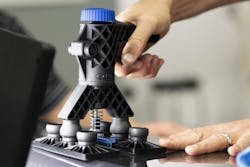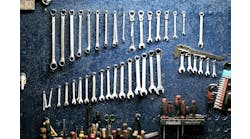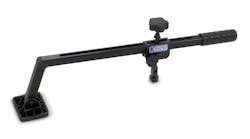Auto makers have experimented with various manufacturing materials over the years. Steel, iron, composites, plastic, aluminum and even wood have been the materials of choice. Other manufacturers have used plastics and composites for years on door panels, bumpers, fenders and more. Remember the salespeople at Saturn dealerships demonstrating the toughness of their cars’ plastic body panels by jamming a shopping cart into a door or kicking the panel, resulting in no damage?
Today, aluminum is getting most of the press for a number of reasons. Car makers use it in doors, hoods, trunks—even in complete vehicle structures. According to the Aluminum Association, aluminum has the strength of steel but weighs 50 percent less, indicating significant savings in energy efficiency, meaning more miles per gallon of gas or diesel. As an added benefit, over 90 percent of aluminum in a vehicle can be recycled at the end of its life.
Stud Welding
Technicians use stud welding for panel repair in most body shops. Stud welding entails welding aluminum studs into the panel, attaching a pull tool to the studs and pulling the dent out from the front. Stud welding does not always involve removing the panel but it still requires substantial pounding, filling, sculpting and finishing work.
Anyone who has ever stud welded to repair a dent can tell you how difficult it can be. Aluminum studs often pop off during the pull, meaning you may have to re-weld or try to make the pull with the remaining studs, perhaps inviting more damage if that doesn’t work. In addition, when removing the studs after the pull, you can easily tear holes in the metal, creating a longer and more expensive repair. When you are finally done with your pull, you still have to remove the studs, skim coat and finish the area.
The reason studs sometimes pull out is because they cover too little surface area on the panel and the surface area isn’t large enough to sustain the force of the pull. As a result, when you pull, you often rip holes in the panel as the studs pull out because the metal is too weak. How, then, do you increase the surface area to pull without creating holes and welding more studs?
GPR Advantages
With glue pull repair (GPR), you attach a plastic piece, called a tab, to the damaged area. The tab covers much more surface area than a stud, so you have more area of the dent with which to pull. This allows you to apply more pulling power without fear of additional damage to the panel in the form of holes. In addition, because you didn’t have to stud weld, you don’t violate the surface of the panel or anything on the backside.
GPR provides an efficient and clean way to pull the dent. With its tab-and-adhesive method of pulling, after the adhesive is set, you attach your pull tool to the tab and pull the dent out. Once you’ve pulled the dent, you simply remove the adhesive with a spray of isopropyl alcohol, do some minor knock-down work, skim coat and finishing, and you’re through. No studs breaking off and no additional holes to fill as a result.
Use Your Own Tools
Glue pulling is a straight swap for stud welding or wiggle-wire setups where you’re obligated to utilize the pulling techniques and tools on hand. KECO-brand adaptors, tabs and glue are extremely cost effective compared to purchasing aluminum-specific tools and components. KECO offers adapters so that you can continue to use the bridges and fulcrum bars you already have in your tool box. You can enter the aluminum body repair business tomorrow and be on your way to increased revenue and improved shop efficiency with GPR.
KECO, the Premier GPR Specialists
GPR began in the early 2000s. But the adhesives and tabs back then were weak and often broke, and tool systems were not readily available. As a result, select technicians only used the “magic” of GPR on lighter pulls and to accent body shop work on large pulls. Since those early years, KECO has been at the forefront of improving these techniques and tools and has taken them to a level that allows body shops to adopt them with ease.
To see the power of GPR, check out KECO’s YouTube channel or shop the entire assortment of KECO Body Repair Products as well as many of the other premier brands in dent repair at kecotabs.com. Check out KECO on Facebook as well.
For 5 percent off of your next order, enter the promo code: FENDERBENDER5 at checkout. Orders placed before 2 p.m. ship the same day and collision kits all come with free shipping.




